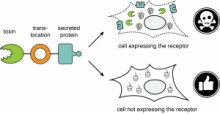This technology relates to a novel method to discover receptors for extracellular proteins in an unbiased fashion. The approach is based on a simple concept: bacterial exotoxin, when fused to a secreted protein, intoxicates cells in a receptor-dependent manner, which facilitates the identification of the cognate receptor through genome-wide CRISPR/Cas9-based positive selection screen.
OPPORTUNITY
Disruption of intercellular signaling is causally implicated in developmental disorders, cancer, and immune disorders. Secreted signaling factors trigger a specific signaling cascade once bound to their specific receptor at the surface of the target cell. Thus, the identification of ligand/receptor interactions has far-reaching implications for both fundamental biomedical research and therapeutics. Therefore, pairing secreted proteins to their cell-surface receptors is a critical step in understanding the basic signaling mechanisms underlying intercellular communication and in developing novel therapeutics. Although modern protein-protein interaction assays have been very successful in characterizing interactions between soluble intracellular proteins but there are no easily scalable methods for studying receptor/ligand interactions in an unbiased fashion. A few other shortcomings of these high-throughput assays range from incompatibility with multi-spanning membrane receptors (such as GPCRs) or multi-subunit receptors to non-translatability from an in vitro to in vivo model systems.
COMPETITIVE ADVANTAGE
- Powerful platform technology for discovery of novel drug targets
- Assay takes place in living cells with receptors in their native state
- Compatible with multi-span membrane proteins, such as GPCRs
- Unbiased: does not require cloning, expression, or purification of candidate receptors
- Not limited to receptors, as can also identify quality-control factors that regulate receptor trafficking, folding, and endocytosis
- Biologically significant readouts
- Assay can be performed in virtually any cell line that can be cultured
IP STATUS: A provisional patent application filed





